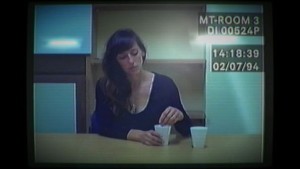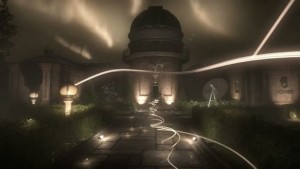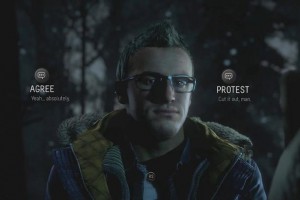 I finally got around to playing through Her Story last week, and as a result, I’ve been thinking a lot about what a game can be and what a game can do. Indeed, Alisha has already written previously about the fact that there is even discussion about whether or not Her Story actually is a game due to its ambiguous ending and due to the fact that failure isn’t really possible in the type of gameplay it implements. And what strikes me about this debate is that, ultimately, it seems to speak to the variety of ways a game can unfold and the variety of ways we can engage with them.
I finally got around to playing through Her Story last week, and as a result, I’ve been thinking a lot about what a game can be and what a game can do. Indeed, Alisha has already written previously about the fact that there is even discussion about whether or not Her Story actually is a game due to its ambiguous ending and due to the fact that failure isn’t really possible in the type of gameplay it implements. And what strikes me about this debate is that, ultimately, it seems to speak to the variety of ways a game can unfold and the variety of ways we can engage with them.
So, I’ve been thinking a lot about how Her Story works as a game. But I’ve also been thinking about how its structure speaks to some of the other games I’ve been playing recently, games that seem to allow us to interrogate what makes a game a game—games that seem to work, in part, to trouble the boundaries of game structures. And whether these games do so through the construction of narrative or the use of choice-based mechanics, or whether they do so through experimental game worlds or ambiguous, abstract storytelling styles, what these games all seem to have in common is the fact that they raise similar questions for me—how might the manner in which we engage with such games, how might the manner in which we interact with them, challenge the ways we think about what video games might have to offer?
 One of the games that have led me to embark on this line of questioning is Everybody’s Gone to the Rapture, a game that seems to be an exercise in restraint. And this restraint operates on multiple levels—it’s a restrained, peaceful post-apocalyptic story, one absent of the monsters and horrors that are prevalent in more traditional apocalypse narratives (indeed, one absent of people in general), and it’s a game with restrained, almost simplistic gameplay. But this interplay between simple mechanics and muted setting is complicated by its fractured, disjointed storytelling style, one that slowly reveals its narrative in abstract fragments, one piece at a time. There is depth, then, to this simplicity, for it (like Her Story, too) forces us to put the pieces of this narrative puzzle together for ourselves and to extract meaning from it, which is both a playful and moving undertaking in and of itself. In this way, Everybody’s Gone to the Rapture, while seeming to be a simple story of post-apocalyptic tragedy on its surface, rather, reveals itself as being more complex than that through the manner in which it asks us to interact with its fragmented (yet interconnected) narrative of loneliness and isolation, thereby complicating our understanding of the manner in which we might engage with a game about the end of the world.
One of the games that have led me to embark on this line of questioning is Everybody’s Gone to the Rapture, a game that seems to be an exercise in restraint. And this restraint operates on multiple levels—it’s a restrained, peaceful post-apocalyptic story, one absent of the monsters and horrors that are prevalent in more traditional apocalypse narratives (indeed, one absent of people in general), and it’s a game with restrained, almost simplistic gameplay. But this interplay between simple mechanics and muted setting is complicated by its fractured, disjointed storytelling style, one that slowly reveals its narrative in abstract fragments, one piece at a time. There is depth, then, to this simplicity, for it (like Her Story, too) forces us to put the pieces of this narrative puzzle together for ourselves and to extract meaning from it, which is both a playful and moving undertaking in and of itself. In this way, Everybody’s Gone to the Rapture, while seeming to be a simple story of post-apocalyptic tragedy on its surface, rather, reveals itself as being more complex than that through the manner in which it asks us to interact with its fragmented (yet interconnected) narrative of loneliness and isolation, thereby complicating our understanding of the manner in which we might engage with a game about the end of the world.
 The Magic Circle also seems to work to complicate our understanding of how we engage with games; yet, while Everybody’s Gone to the Rapture does so through its use of restraint, The Magic Circle, instead, does so through what feels like an unconstrained postmodern game world, one that seems to be an indulgent exploration of the excesses and freedoms such a world might afford. And it specifically does so, in part, through its use of metafictional devices, through its use of parody and satire, to point to the artificiality of its world, which it seems to do in an effort to critique both the process of making a game and the process of playing one. This playfully experimental intersection of critique and narrative, of commentary and game—this metanarrativity—seems to work in a disruptive fashion, as explicitly evidenced in the disrupted landscape of the game, a landscape that has us, in one moment, traversing through the forest of a fantasy world and, in the next, exploring the space station of a science fiction one; in other words, The Magic Circle seems to work to unsettle the norms of traditional gameplay and traditional game-narrativity by making use of metafictional critique.
The Magic Circle also seems to work to complicate our understanding of how we engage with games; yet, while Everybody’s Gone to the Rapture does so through its use of restraint, The Magic Circle, instead, does so through what feels like an unconstrained postmodern game world, one that seems to be an indulgent exploration of the excesses and freedoms such a world might afford. And it specifically does so, in part, through its use of metafictional devices, through its use of parody and satire, to point to the artificiality of its world, which it seems to do in an effort to critique both the process of making a game and the process of playing one. This playfully experimental intersection of critique and narrative, of commentary and game—this metanarrativity—seems to work in a disruptive fashion, as explicitly evidenced in the disrupted landscape of the game, a landscape that has us, in one moment, traversing through the forest of a fantasy world and, in the next, exploring the space station of a science fiction one; in other words, The Magic Circle seems to work to unsettle the norms of traditional gameplay and traditional game-narrativity by making use of metafictional critique.
 And, Until Dawn, too, though there may be problems in its representation of gendered and raced stereotypes, is a game that seems to work to challenge how a game might be structured and what a game can be. To be sure, the fact that some people refer to the game as a sort of “interactive horror movie” is, in itself, revelatory of the manner in which the game calls into question the sorts of assumptions we may have regarding how we might (or should) interact with a game and regarding its mechanics and gameplay. In other words, the mere fact that some people don’t refer to the game as a game but, instead, as an interactive movie reveals a sort of resistance to the type of choice-based gameplay Until Dawn implements, a resistance that seems to occur as a result of the kinds of normative expectations people might have regarding the ways games are played. As such, the fact that Until Dawn allows us to have conversations about this resistance and the fact that it asks us to interact with it differently affords us the opportunity (as do the other games mentioned in the previous paragraphs) to interrogate how it is that games might be working to operate differently.
And, Until Dawn, too, though there may be problems in its representation of gendered and raced stereotypes, is a game that seems to work to challenge how a game might be structured and what a game can be. To be sure, the fact that some people refer to the game as a sort of “interactive horror movie” is, in itself, revelatory of the manner in which the game calls into question the sorts of assumptions we may have regarding how we might (or should) interact with a game and regarding its mechanics and gameplay. In other words, the mere fact that some people don’t refer to the game as a game but, instead, as an interactive movie reveals a sort of resistance to the type of choice-based gameplay Until Dawn implements, a resistance that seems to occur as a result of the kinds of normative expectations people might have regarding the ways games are played. As such, the fact that Until Dawn allows us to have conversations about this resistance and the fact that it asks us to interact with it differently affords us the opportunity (as do the other games mentioned in the previous paragraphs) to interrogate how it is that games might be working to operate differently.
But I think that there’s something else important at work in games like these, something else that bears pointing out. Thus far, I’ve been talking about how such games challenge the way we think about what a game is. But I think they also challenge the way we think about what a narrative is and how stories can be told. And by thinking about how the boundaries of storytelling can be tested in the ways that games like Her Story or Until Dawn test them, we might also extend this line of thinking to consider our role in all this—we might consider the manner in which we engage with stories more broadly.




